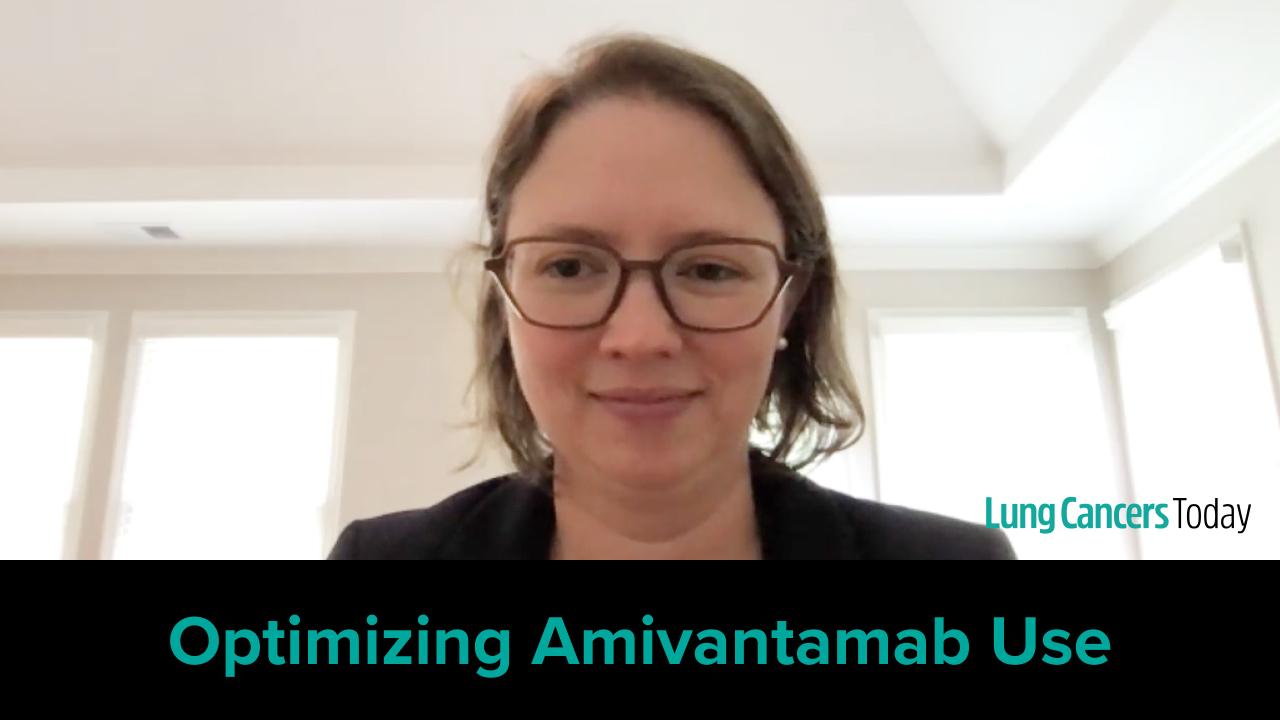Dr. Catherine Shu Discusses a Study With Important Implications for Lung Cancer Treatment
By Rob Dillard - Last Updated: February 28, 2025DocWire News spoke with Dr. Catherine Shu, a board-certified medical oncologist specializing in the treatment of thoracic cancers, specifically lung cancer, on the findings from Janssen’s CHRYSALIS-2 study, which demonstrated the efficacy of amivantamab in combination with lazertinib in the treatment of patients with non-small cell lung cancer.
DocWire News: Can you give us some background on yourself?
Dr. Catherine Shu: Sure. I’m an assistant Professor of Medicine here at Columbia University Medical Center, I’m the Clinical Director of the Thoracic Medical Oncology Group, and I am a lung cancer doctor and a lung cancer researcher, and I love what I do.
What prompted you and your colleagues to conduct the CHRYSALIS-2 study?
Well, I had heard about this drug. We actually started with this drug very early on, and I just thought the science behind it was really interesting. It’s a bispecific antibody targeting you EGFR and MET, and that’s a really important pathway. The EGFR mutation in particular, but then also a lot of the acquired resistance pathways are through MET. So I thought that this would be a great drug. And so we actually had signed up to conduct the study, actually the CHRYSALIS study, from the very beginning. And then as we continued on seeing some great responses, we also signed on to do CHRYSALIS-2.
How was the study conducted, and what were the findings?
CHRYSALIS-2 combines amivantamab, which is that EGFR-MET bispecific antibody, with lazertinib, which is a third-generation tyrosine kinase inhibitor, and it combines the two. In the CHRYSALIS-2 study that was presented at ESMO, we were looking at the post-osimertinib, post-platinum population. So these were patients who had progressed on osimertinib and then on chemotherapy/ and right now there really isn’t any good treatment regimen for them after they’ve progressed on those prior therapies, so this is kind of an unmet need.
What we did was we looked at, and the endpoints were overall response rate, but we also looked at things like duration of response, clinical benefit rate, progression-free survival, and then importantly, the safety profile, which is the adverse events. In the target population, which is that post-platinum post-osimertinib population, we saw that there was a response rate of 41%. The clinical benefit rate was 69%, so that also includes people with disease stability. We saw responses very early, so some people were responding at 1.5 Months at that first scan. And out of 12 patients who responded, 8 of them continue to be progression free and remain on treatment. So it’s great numerically, and also great to see in clinic when people have their disease shrink.
Just in terms of safety, which is another really important part of the study, we found that the combination of the two drugs was well-tolerated. The main issues tend to be things that are EGFR-related, which rash, paronychia, stomatitis, so mouth sores. But in general, well tolerated. And I would say the most important thing that everyone’s asking about with amivantamab is this idea of the infusion-related reaction, which we saw first with CHRYSALIS and we also see with CHRYSALIS-2.
But the drug can cause an infusion-related reaction, which is typically on the first day of infusion. So on that cycle one day 1, patients, they might experience an infusion reaction, which can be increased blood pressure, flushing, some chest pains, some shortness of breath. And it’s typically within the first few minutes of the infusion. We stop the infusion, we slow down the rate, we give them additional medications, and then most people are able to get through it. We’ve really learned a lot about the infusion reaction since the first days, and we give people pre-medications, we really know how to manage it. And then most people never have that infusion-related reaction again, after the first day. So I think that’s an important thing for physicians and for patients to know.
What were the study limitations?
The study, it’s a small population, especially in that target population that we were looking at. So we’re interested in seeing, as the study continues on and just gather more patients. There are a couple other cohorts of interest in CHRYSALIS-2. There is an exon 20 insertion cohort. Amivantamab is now FDA approved for exon 20, but as a monotherapy. And we’re trying to see if we add in lazertinib, if that’s going to make a difference. There’s a cohort for atypical mutations. That’s another unmet need that we’re still trying to figure out. And there’s a cohort that’s for post-osimertinib biomarker validation to see what types of acquired resistance mutations might be the most relevant for this type of drug.
And then I would say the other important thing about limitations or other added benefits of this drug is really to figure out the CNS penetration. That’s a really important thing. A lot of these patients have brain disease, and the reason that lazertinib is particularly exciting to me as an addition to amivantamab, is that lazertinib has known brain penetration, similar to the way osimertinib does. So, does adding lazertinib improve that CNS penetration? And I think that’ll an important question to ask.
What are the clinical implications of these findings?
Yeah, I think it has a lot of clinical implications. Because like I said, this wasn’t like an area that… This is kind of an unmet need. So if we’re able to show that post-osimertinib post-platinum-based chemotherapy, this is the next line, I think that that’s huge. Because these patients really, they often do live for a longer period of time and they need other treatments after those initial ones. So I think that this could really slide nicely into the whole paradigm of treating EGFR mutations. And actually, interestingly, there’s another trial called MARIPOSA that is looking at this combination in the first-line against osimertinib. So is this going to be a first-line regimen? Is this going to be a second-line regimen? Is this going to be a third-line regimen? I think all of those questions are still unanswered and are interesting.
Any closing thoughts?
Well, I would say that I just had a patient I put on to single-agent amivantamab for an exon 20 insertion and she had this giant chest mass. And on day 1 of the infusion, she said she immediately felt better. She felt like it was softening. And I was like, day 1, it seems a little bit of maybe a tall tale. But the infusion is given weekly, so I see her every week. And by that third week, I can’t even tell you that the chest wall mass has completely shrunken down and her chest wall is like flat now.
So the drug definitely works. It clearly works and I think we’re all excited, as investigators, to have been able to work on it. But really, I think the question is going to be, what situation is it best in? What drugs and combination is it best in? And how do we kind of maximize the benefit for the most number of patients?







 © 2025 Mashup Media, LLC, a Formedics Property. All Rights Reserved.
© 2025 Mashup Media, LLC, a Formedics Property. All Rights Reserved.